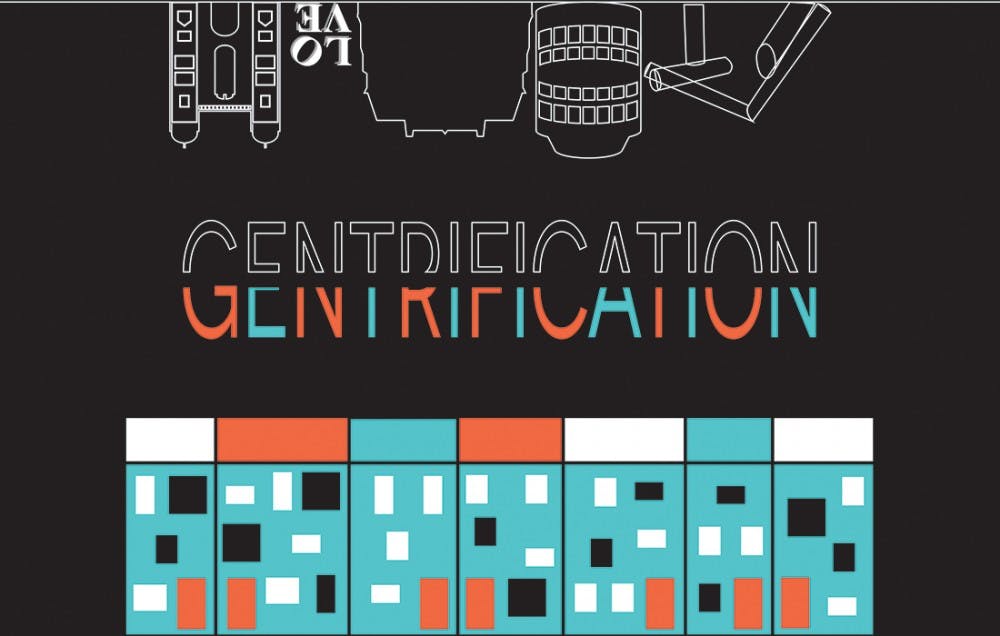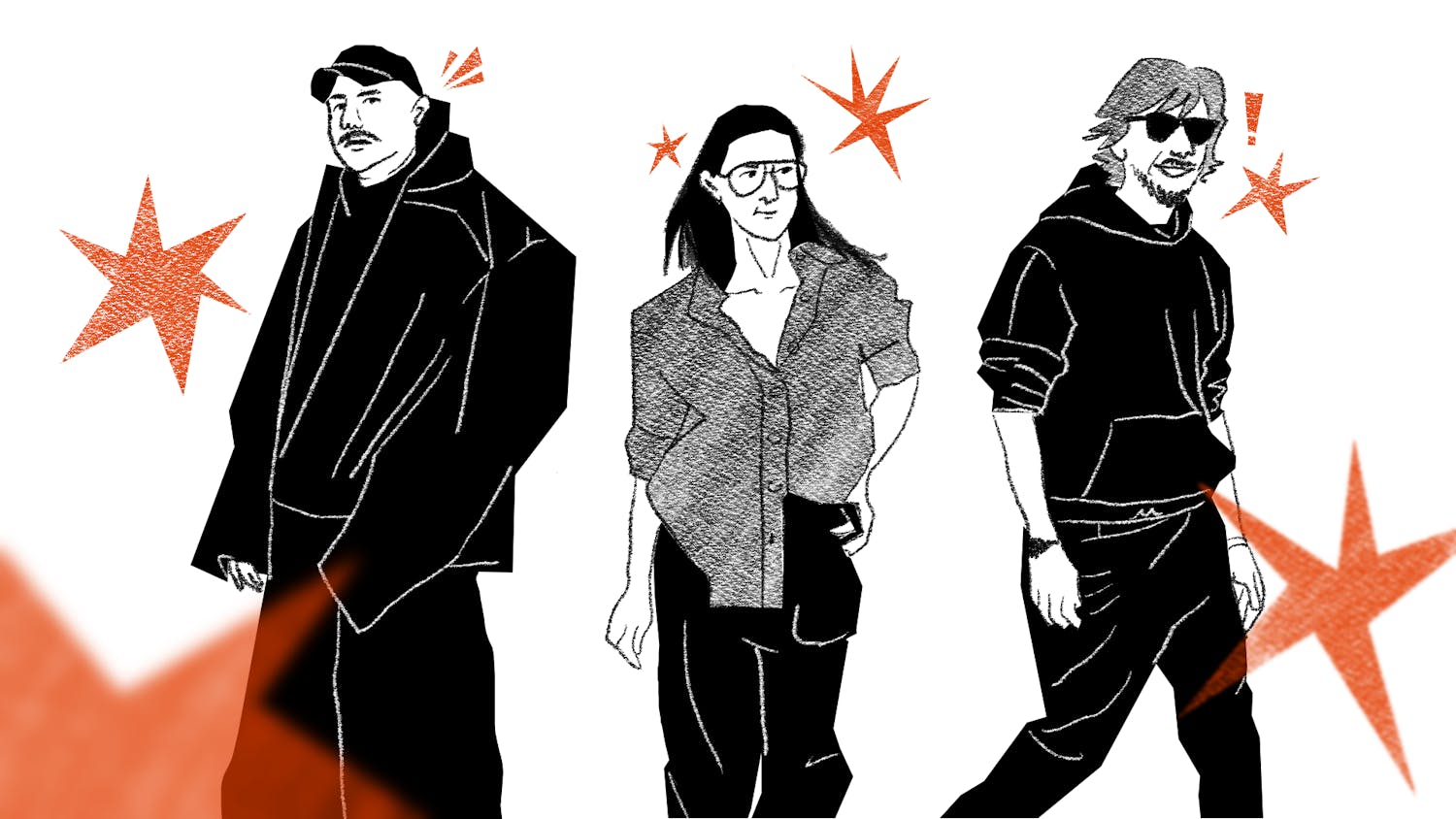West Philadelphia has been called many names over the years. A sprawling suburb, a quiet collegiate enclave, a dangerous part of town, an area of interest for developers. Today West Philadelphia bears one particular descriptor: gentrified.
Phil Tedros (C ’20) lived in the Southwest Philly neighborhood of Eastwick prior to coming to Penn. Eastwick is, as he says, “super residential,” replete with rowhomes and mom–and–pop shops. “You can get a sandwich and a bag of chips for three dollars.”
“I think for now Eastwick’s outside of [Penn’s] reach,” Phil said wryly. To him, it’s untouched by the tentacles of development, a community similar to West Philly 20 years ago.
The concept of gentrification is a muddled one. Does it push long-time residents out in favor of the highest bidder? Or does it help low-income communities? And what does it say that we exist in a gentrified space—one that our school created?
“Penn is still displacing people, plain and simple,” Casey Lynch (C ‘18), who has been involved with the Netter Center for four years, said. “I can't see how that would be positive.”
And no one can question the rapidity with which it’s occurring.
Pushed out by Penn
In the 1960s, sociologist Ruth Glass provided an evergreen definition of gentrification: when “working class quarters have been invaded by the middle class...until all or most of the working class occupiers are displaced and the whole social character of the district is changed.”
Gentrification’s link to displacement is undeniable. New groups and institutions inundate an area and push out those who lived there before. Rents rise, and residents like Clare Finn, who grew up in West Philly and lives there now as an adult, are “priced out of their own neighborhoods.”
She recalls that the value of her parents’ house appreciated 400% in the time they lived in Philly. She and her siblings couldn’t afford the new property tax.
A 2016 study by the Federal Reserve Bank of Philadelphia found that the city has lost roughly 20,000 low–cost rental units (rent and utilities under $750) since 2000. The black population in West Philly has decreased by 29% from 2000 to 2012.
The Preservation Alliance for Greater Philadelphia, under President Paul Steinke, often crosses paths with Penn and Drexel. “For the most part, Penn is now a good steward of the neighborhoods it inhabits,” he explains. “A few generations ago, though, this was not the case.”
Penn has just recently begun to acknowledge the history of urban upheaval it’s caused. Penn’s Civic House sponsored an urban studies class (URBS 178) on university–community relations that addresses the school’s difficult history with its surroundings.
Many native West Philadelphians declare, often on bumper stickers: “This is West Philly. UCity is just a marketing scheme.”
Penn still plans to continue building north of Market and west of 43rd. And resentment towards Penn simmers in the West Philly community.
The Master Plan and Black Bottom
In 1977, against the backdrop of a rapidly expanding Penn, the University of Pennsylvania’s Real Estate Development Office called the Powelton Village Development Agency (PVDA) to a meeting.
Phyllis Dennis (C ’76), then a PVDA employee, recalls the meeting, saying that Penn’s representatives brought in a massive map covered in blue and red pins, which represented planned university development both on and off–campus. Dennis witnessed one of the earliest unveilings of Penn’s Landscape Development Plan of 1977. Its stated aim was to make Penn “reasonable, alive, and healthy once again. It also goes by another name—the Master Plan.
The Plan’s effects were keenly felt in the Black Bottom, a primarily black and disadvantaged neighborhood that earned its name from its place at the “bottom” of West Philadelphia (from 32nd Street to 40th Street between Lancaster Ave and University Ave). Penn, USciences, the Philadelphia College of Osteopathic Medicine, Presbyterian Hospital, and Drexel formed the West Philadelphia Corporation (WPC) in 1959 and began to condemn buildings across Black Bottom. The city had the power to seize land under eminent domain—which allowed them to dice the community with the aim of making West Philly “a satisfactory residential community” and helping it “to fulfill its potential as a center of private research.”
These land seizures, coupled with the 1963 construction of the University City Science Center, fractured the community. For many Philadelphians, the ‘60s and ‘70s made evident Penn’s active role in spreading gentrification outward from campus.
Dr. Walter Palmer, a native of the Black Bottom and lecturer at the Penn Graduate School of Social Policy and Practice, went away to law school in the late 1960s. When he returned to the house where his mother and stepfather lived on 3643 Market Street, the neighborhood had changed. Penn was in search of a grant for “urban renewal” at the time; but the grant stipulated that the neighborhood needed to be blighted (i.e., so unsafe, uninhabitable, or dilapidated that it is a candidate for eminent domain).
Penn, “unbeknownst to renters, created the blight it needed,” Dr. Palmer explained. In buying up properties in the Black Bottom en masse and then having landlords evict longtime residents, they made space for the now–primarily commercial development on Market Street.
Dr. Palmer’s family was evicted from their home in 1969. He recalls that, before much of the neighborhood was displaced, there were around “5,000 residents who cared about each other.” Many of the Bottom’s residents have gathered for a reunion in Fairmount Park every year since the mid–1970s. It’s a tradition that continues to this day. But, Dr. Palmer says, “the people went everywhere. They lost their safety, their support systems.”
Penn Outside the Bubble
Penn encourages students and faculty to explore off campus.
The Netter Center offers ABCS (Academically Based Community Service) courses in which students can interact with the surrounding community. But Phil thinks that student initiatives, when hollow, don’t absolve them of complicity.
When students go out and work in West Philly, he sees it as lacking a “long–lasting partnership.”
In his estimation, ABCS courses “send some untrained, rich, and wealthy students who are not from here out into West Philadelphia, who act like they really understand the neighborhood and know what they’re doing. But in reality they’re just untrained, typically nonchalant kids.”
“I think that Penn students are complicit in ‘Penntrification,’ though I think that the more significant blame lies with the institution,” Casey adds.
Penn also offers incentives for its faculty to reside in nearby West Philadelphia. Ella Comberg, a longtime West Philadelphia resident, describes the university as a “kind of silent but huge presence in [her] life.”
She spent most of her young life in a house on 43rd Street and Larchwood Avenue and attended the Penn Alexander School. Her father, David Comberg, teaches in the School of Design at Penn, but the family initially moved to the area for his job at UArts.
Ella is critical of her former school, and how she thinks it “serves the University and its faculty’s families more than unaffiliated West Philly residents.” Penn Alexander receives operating contribution of $1330 per student from the university, in addition to staffing and teaching assistance from Penn’s Graduate School of Education.
Penn professors benefit from Penn’s Home Ownership Services, which helps Penn faculty and staff “apply for closing cost assistance for home purchasing and funds towards home improvement.” This incentivizes university affiliates to buy property in the area, and to send their kids to school in the district. In effect, Penn undermined its own efforts to serve its proximate community, by replacing residents with more of their own.
A Past and Future of Gentrification
There has been a huge uptick in gentrification since 2000. Census data, when adjusted for inflation, indicates a massive jump in Philadelphia property values—an average increase 213% since 2000.
That’s typical for a gentrifying city. Since 2000, developers have responded to a growing demand for off–campus housing, building apartment buildings like Domus and The Radian.
The Gothic brick building at 47th Street that used to house West Philadelphia High School has been repurposed into West Lofts, whose “market–rate” apartments run from $995 for a studio to $2430 for a three–bedroom. The old Gothic auditorium will be turned into a “coworking space” and a coffee shop. The students have been moved into a new building at 4901 Chestnut.
Ed Datz, Executive Director of Real Estate at Penn Facilities and Real Estate Services (FRES), noted that his office is “always looking at what’s happening in the surrounding neighborhoods and at residential opportunities.”
Datz mentioned the newly–opened Pennovation Center, which opened last year across the river in Gray’s Ferry. He mentions the Pennovation Center, housed in an old DuPont–owned paint factory. The University bought the land and the building and now uses it as an incubator for local startups and student research.
He also confirmed Penn’s involvement in a new mixed–use development in the 4600 block of Pine Street. This new four–story building will have 21 apartment units, and Penn Family Medicine University City will move into the first floor office space from its building a few doors down at 4623 Spruce St. The plot of land used to house the Transition to Independent Living Center, which formerly provided affordable assisted living for aging adults with below–average incomes, before it burned down six years ago and has since laid vacant.
Ivy League Expansion
Penn’s expansion originally centered on Locust Walk. By the 20th century, Penn had established itself as the most well–endowed entity in West Philadelphia and maintained an uneasy symbiosis with the community.
Soon after, Penn moved westward. This move brought with it an influx of capital and incentives for real-estate developers to create housing for well-endowed students.
Ira Goldstein, a lecturer in Penn’s Urban Studies department and the president of Policy Solutions for the Reinvestment Fund, teaches a course on gentrification. Philadelphia, in Pew’s 2017 State of the City study, lacks affordable or subsidized housing options. The Philadelphia Housing Authority’s waiting list peaked in 2014 at around 78,000. It’s now down to 42,000.
A 2014 study by the Philadelphia Federal Reserve neighborhood change also cites an approximately 20% drop in affordable housing in Philadelphia from 2000–2014. From the Fed’s press release: “the losses were especially acute in University City.” Ira, explains it as, “West Philadelphia experiences [loss of affordable housing] to a much greater extent because home values appreciate so much faster than income.”
It’s not just homes. Restaurants, shops, bars—they’ve all widened the Penn bubble. Older Penn alums may never have ventured West of 41st Street Penn students now regularly grab drinks at Local 44 at 43rd St. and Spruce or brunch at The Farmacy at 44th.
But for many students residing in the “Penn Bubble,” community issues take a backseat. How do students pop this proverbial bubble? Ella suggests that “gentrifiers in West Philly, including Penn students, have a huge responsibility to really engage with their neighbors, old and new, and to work to make sure the neighborhood isn’t pushing more people out.”
Checks and Debts
It all comes down, in the end, to money. Who has it, who doesn’t, and where it’s spent. Penn’s status as the largest employer in Philadelphia, its large endowment and the socio–economic position of its students and staff complicates its existence in West Philadelphia.
Especially since, as Ella puts it, there’s a kind of “feedback loop of gentrifiers complain[ing] about gentrification without acknowledging that they're complicit.”
When asked what Penn owes to the communities it inhabits, Phil talks for a while before pausing to take a deep breath: “It just owes them their space.”
***
Annabelle Williams is a sophomore in Wharton from Chester Springs, PA, studying Management and Marketing. She is the Highbrow Editor for 34th Street.







